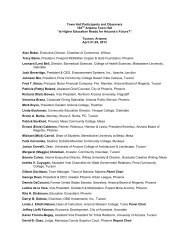Background Report - Arizona Town Hall
Background Report - Arizona Town Hall
Background Report - Arizona Town Hall
Create successful ePaper yourself
Turn your PDF publications into a flip-book with our unique Google optimized e-Paper software.
Dr. Charles C. Di Peso said that they were lucky to have had only two visitors to the Amerind<br />
Museum that month, so there were few distractions to getting an important research project<br />
written up!<br />
In 1984 the Amerind opened its museum and fine art gallery to the walk-in public and visitation<br />
steadily rose to the current level of 12-15,000 visitors a year. The Amerind is truly a rural<br />
museum, and there are advantages and disadvantages to being in the “middle of nowhere.”<br />
Other than the spectacular rock formations of Texas Canyon and the beautiful sunsets of<br />
southeastern <strong>Arizona</strong>, visiting scholars and advanced seminar participants have few things to<br />
distract them from their important work. On the other hand, the Amerind is an hour’s drive<br />
from Tucson and Sierra Vista and twenty minutes to the nearest restaurant, grocery store, or<br />
pharmacy. Moreover, Cochise County has very little wealth, few corporations, even fewer<br />
non-profits, and almost no history of philanthropy. Without a solid community of support,<br />
fund raising for new programs and capital improvements is difficult, to say the least. As the<br />
Amerind approaches its 75th anniversary in 2012, its biggest challenge will be to transform a<br />
closely kept secret into a household name and popular visitor destination. As a cultural attraction,<br />
it will contribute to the economy of this remote location.<br />
Tribal Museums: From Display Cases to Cultural Preservation<br />
Manuelito Wheeler, Director, Navajo Nation Museum, Window Rock<br />
A current trend in museums nationally is to be more in tune with their communities and not<br />
operate as empirical institutions. The Navajo Nation Museum, for example, operates by this<br />
trend. The Museum opened in 1961 with the help of the Navajo Council, and initially and<br />
for some decades it functioned as an anthropological museum having historical exhibits and<br />
displaying artwork. Currently the Navajo Nation Museum’s mission statement is “Striving to<br />
achieve hozho through contemporary and traditional exhibits, programs, and tours; To<br />
promote our Diné culture, language, history, and sovereignty.” (hozho is a Navajo word<br />
meaning harmony, balance, spiritual beauty).<br />
Tribal museums throughout <strong>Arizona</strong> are evolving into cultural preservation centers. Topics of<br />
language preservation, traditional religion retention, and public display appropriateness are<br />
some issues at the forefront of tribal institutions. It was unforeseen that tribal museums would<br />
be in positions of cultural preservation and salvation.<br />
Supporting local artists is another obvious goal of museums, tribal or not. This task is a little<br />
more complicated for tribal members because the definition of Native art is fuzzy and<br />
sometimes controversial. Traditional art and contemporary art for Indian people carry with<br />
them rules of what is appropriate. These issues are to be kept on the periphery but we must<br />
not lose sight of supporting local artists. Many artists who live on the reservation have<br />
little experience dealing with museums, assembling a portfolio, or even visiting museums<br />
and galleries. Many of these talented reservation artists remain undiscovered.<br />
At the Navajo Nation Museum, having Navajo staff members has the benefit of the inherent<br />
understanding of Navajo culture, which is as diverse as its people with regional beliefs, politics,<br />
and minor linguistic differences. Thus the staff can share common cultural knowledge as<br />
well as defering to traditional specialists for more sacred knowledge.<br />
Chapter 16 | 169




